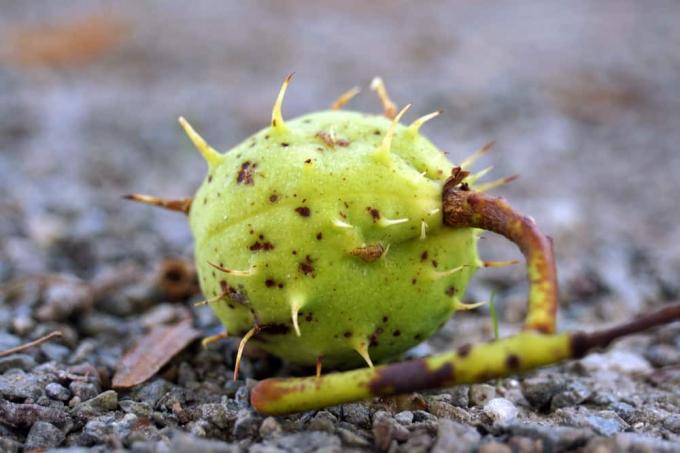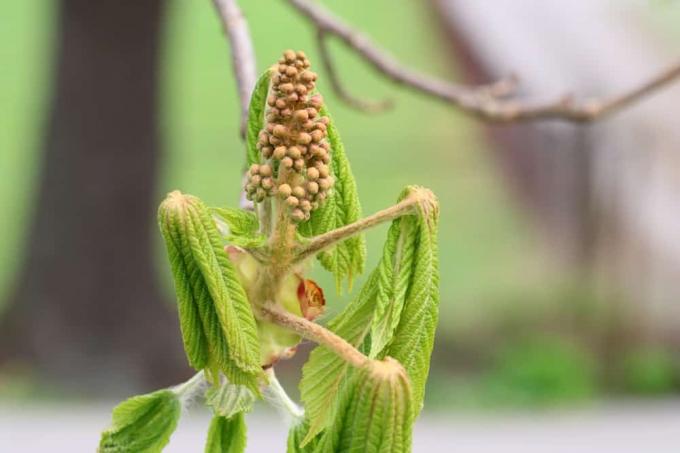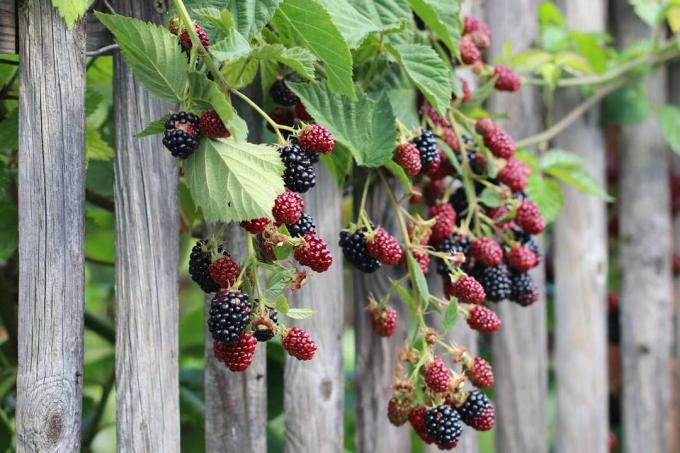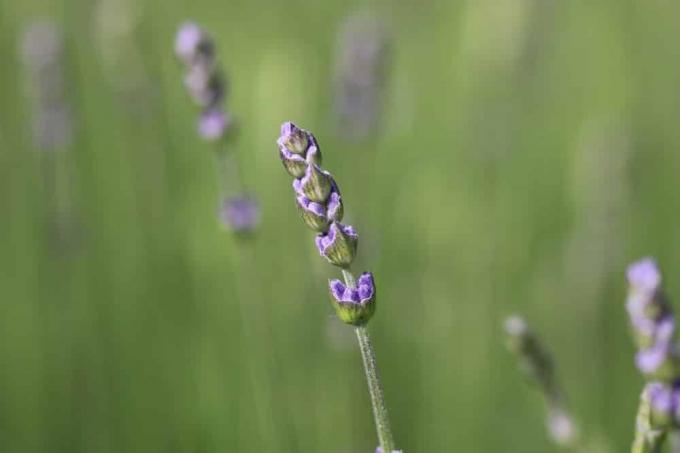

Table of contents
- When is the best time to prune a chestnut tree?
- types of pruning
- The education cut
- The clearing cut
- The Cleanup Cut
- The crown cut
- How does the cut have to be done step by step?
- What mistakes should you avoid?
- Cut correctly with the ideal cutting tool
- Should you cut off faded flowers?
The best time of year to prune a chestnut is during the cooler months, from early November to early March. It should be cool but frost-free outside. At sub-zero temperatures, frostbite would occur at the interfaces and damage the tree. With outside temperatures above four degrees, the conditions for a fungal disease are ideal. Fungal spores penetrate the wood via the fresh cuts and can severely damage the tree in the long run.
When is the best time to prune a chestnut tree?
The chestnut is one of those trees that are poorly able to ward off invading germs. Have your chestnut tree trimmed by a professional. He knows how sensitive the chestnut tree is to pruning measures and acts accordingly.
types of pruning
– When can a chestnut be cut? –
It is best to start pruning a chestnut tree at a young age. From the age of two, you can slowly build up the scaffolding of the young tree with regular training cuts. Now the branches that have to be removed still have a small diameter, so the cuts in the wood are also small and offer little surface for fungal spores and other germs to attack. If you also observe the right time of year for a cut, the wounds on the tree dry quickly and do not become infected with bacteria or fungi. If a stable tree structure is achieved after a few years, it is sufficient to carry out the pruning measures over a longer period of time.
Tip:
Only cut branches that are about 5 cm in diameter. The tree closes the small wounds relatively quickly. Seal the edges of large incisions with an appropriate wound dressing, such as B. tree sap. Due to its soft wood, the chestnut finds it difficult to form a protective zone around the wound. Fungi and bacteria are therefore only poorly repelled.
The education cut

The chestnut tree needs regular pruning for the first 2 to 5 years. This is very important for the vigorous growth of the tree and should be carried out once or twice a year. The right time for this is of course the cool season. With this cut, you choose a strong shoot that grows upwards, which should develop into a strong trunk in the next few years. Cut off any other competing branches cleanly at the base and seal the edges of large wounds with tree sap or something similar. Small cut surfaces dry in the air.
The clearing cut
If the chestnut tree has developed a stable tree structure after a few years and has reached the desired shape, a clearing cut is sufficient for further care. Diseased and dead twigs and branches are removed. The cut is made directly on the trunk. Even branches that disturb the regular growth of the tree, such as twigs that grow inwards and twigs that hinder each other's growth, are cut directly on the trunk. The clearing cut makes room for a new shoot. If the chestnut tree has already been steered into the right growth trajectory with training cuts, clearing cuts are only necessary at long intervals. The older the chestnut tree gets, the less it is cut.
A notice:
Thick branches (more than 5 cm in diameter) should not be cut until autumn unless they are affected by a disease.
The Cleanup Cut
Up to the age of twenty, the chestnut tree needs a pruning about every two to three years. In the undisturbed growth period, the tree has formed many thin shoots that grow upwards, the so-called water veins. On the trunk itself, side shoots are a nuisance, and thin shoots also sprout from the root area, the rootstock, the bud shoots. All of these unwanted rashes are radically removed during the clean-up cut, i.e. right down to the old wood. Widespread side branches and high, unstable trunk axes must be shortened.
The trunk itself is cleaned and examined for diseased areas. Cut out diseased parts and dead wood down to the healthy wood and close the wound if necessary. If pests have nested in knotholes or under the bark, these areas must also be removed.
A notice:
Chestnut blight develops on the bark of damaged wood and must be rigorously removed to prevent it from spreading.
The crown cut
The crown of a chestnut tree also requires regular pruning during its first twenty years of life. Once a strong tree structure is in place, only clean-up cuts are required. If you want to trim the crown properly, cut back its weak branches. Weak side branches and vertical shoots are also trimmed or cut off completely, as they unnecessarily draw strength from the tree. The tree is stabilized by pruning the crown, giving an older chestnut the strength to form new branches.
How does the cut have to be done step by step?

When it's time to prune your chestnut tree again, start with a clean-up pruning. First remove all dead wood and cut diseased branches back into healthy wood. Then shorten excessive trunk axes and side branches that are too long, eliminate water veins and side shoots. As a last measure, you can cut the crown. Here you cut off weak branches and shorten shoots that are too long. If you correct all branches and parts of the crown in this way, the tree can develop a strong tree structure over the next few years.
Tip:
Especially when you cut the crown, there are many cuts on the tree. Since the chestnut tree is very sensitive to injuries, all large wounds in the edge area should be treated with a wound resin or an appropriate ointment to prevent infections with fungi or bacteria from the outset stop.
What mistakes should you avoid?
Before you prune your chestnut tree, you should definitely find out when the best time to do it is. Above all, the right outside temperatures are important. If branches need to be cut off completely, use the scissors directly on the trunk. But be careful not to damage the log. Do not leave any branch stubs, the so-called coat hooks.
Do not wait too long before cutting the chestnut for the first time. You only develop the basis for a healthy and strong tree structure when you are young. Regular pruning ensures good growth.
Use wound resin sparingly and only for large wounds in the wood. Moisture and warmth under the wound balm create ideal conditions for the growth of fungi. Leave cleanly cut small wounds to dry in the fresh air. Large cut surfaces are only coated on the outer edge, where the bark and wood come together. This is where the delicate cambium layer is located, where the cells responsible for tree growth divide.
Cut correctly with the ideal cutting tool
You can only cut properly with high-quality tools. Cut branches with appropriate pruning shears. A telescopic pull-out makes work easier here. A pruning saw may have to be used when cutting the crown.
If you are planning a grooming cut, check that all blades are sharp enough. You can only achieve a clean cut with sharp blades and the cut surfaces can heal well. If necessary, the scissors must be sharpened and blunt saw blades replaced.
Tip:
Many garden centers have departments where your cutting tools can be professionally sharpened.
Just before you start work, clean your work equipment with soapy water. The blades must then be thoroughly disinfected with alcohol so that no germs can penetrate the freshly cut surface.
Should you cut off faded flowers?

When the chestnut blooms, it impresses with beautiful white candles for a few days. Once they have withered, the chestnuts will develop. The fruits are a source of food for many animals in winter and the children collect them for handicrafts. Faded chestnut blossoms should therefore not be removed. Flowers that do not produce chestnuts dry up and fall off the tree by themselves.
 Home editorial office
Home editorial office
Learn more about pruning

Eucalyptus dried up: cut back now?
When a eucalyptus dries up, some owners immediately think of cutting it back. Because they want to see fresh green bud quickly. The chances of that happening may be good. But one thing must not be left out: research into the causes! Otherwise a new cycle of drying up and cutting begins.

Cut blackberries: Instructions for the right cut
Bramble branches only bear fruit for one summer, after which they are used up and die off in winter. It's a good thing that new canes grow back in time for the following year. Cutting care means: What no longer supports should be removed, young rods must be optimally trained.

cutting snowball | 13 tips for pruning
When it comes to snowballs (Viburnum), the opinions of numerous hobby gardeners differ when it comes to cutting. Main reason against pruning: Destruction of the natural appearance by pruning. Find out now when it is unavoidable and which tips should be heeded.

Cutting sage: 6 tips for cutting back
Cutting measures and their ideal time depend on the species of sage plants, because they have differentiated ways of life. There are woody and herbaceous representatives that require different attention. In order to carry out the measures, a basic set of tools is helpful.

Pruning hydrangeas: when is the right time?
Hydrangeas are a real beauty because of their flowers. In the long term, however, the flowering power is only maintained if regular pruning takes place. Because cutting off withered or dried plant parts offers protection. The following guide shows when this measure should be taken.

Cutting Lavender | When is the best time?
Lavender is a popular perennial, but difficult to cut. Without regular pruning, the shrub becomes lignified and less robust. Choosing the right time is important for pruning. When to cut depends on the use of the perennials.
